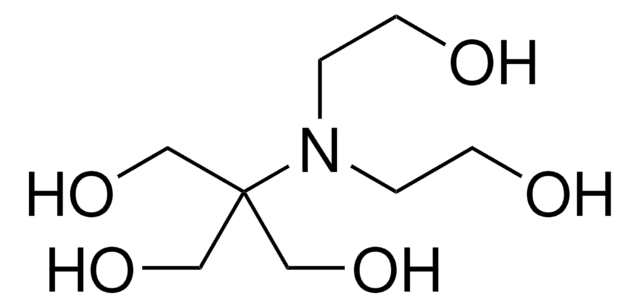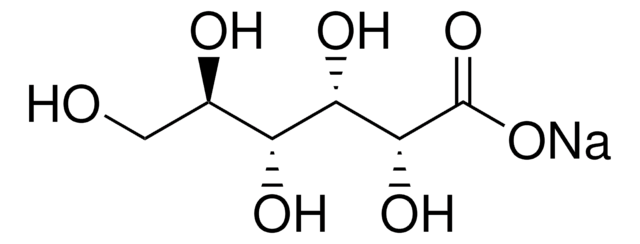T9784
Tricine
BioXtra, pH 4.0-6.0 (1 M in H2O), ≥99% (titration)
Synonym(s):
N-[Tris(hydroxymethyl)methyl]glycine
About This Item
Recommended Products
product line
BioXtra
Quality Level
Assay
≥99% (titration)
form
powder
impurities
≤0.005% Phosphorus (P)
≤0.1% Insoluble matter
ign. residue
≤0.1%
pH
4.0-6.0 (1 M in H2O)
useful pH range
7.4-8.8
pKa (25 °C)
8.1
solubility
H2O: 1 M, clear, colorless
anion traces
chloride (Cl-): ≤0.1%
sulfate (SO42-): ≤0.05%
cation traces
Al: ≤0.0005%
Ca: ≤0.0005%
Cu: ≤0.0005%
Fe: ≤0.0005%
K: ≤0.005%
Mg: ≤0.0005%
NH4+: ≤0.05%
Na: ≤0.005%
Pb: ≤0.001%
Zn: ≤0.0005%
absorption
≤0.05 at 280 in H2O at 1 M
≤0.1 at 260 in H2O at 1 M
application(s)
diagnostic assay manufacturing
SMILES string
OCC(CO)(CO)NCC(O)=O
InChI
1S/C6H13NO5/c8-2-6(3-9,4-10)7-1-5(11)12/h7-10H,1-4H2,(H,11,12)
InChI key
SEQKRHFRPICQDD-UHFFFAOYSA-N
Looking for similar products? Visit Product Comparison Guide
General description
Application
- in a polymerase chain reaction (PCR) buffer used in the single-cell collection
- as a component of lactotroph feeding medium for culturing lactotrophs
- to prepare luciferase assay reagent for luciferase activity assay in firefly Photonis pyralis and as a component in Triton/glycylglycine lysis buffer
Not finding the right product?
Try our Product Selector Tool.
Storage Class Code
13 - Non Combustible Solids
WGK
WGK 3
Flash Point(F)
Not applicable
Flash Point(C)
Not applicable
Personal Protective Equipment
Choose from one of the most recent versions:
Already Own This Product?
Find documentation for the products that you have recently purchased in the Document Library.
Customers Also Viewed
Our team of scientists has experience in all areas of research including Life Science, Material Science, Chemical Synthesis, Chromatography, Analytical and many others.
Contact Technical Service





